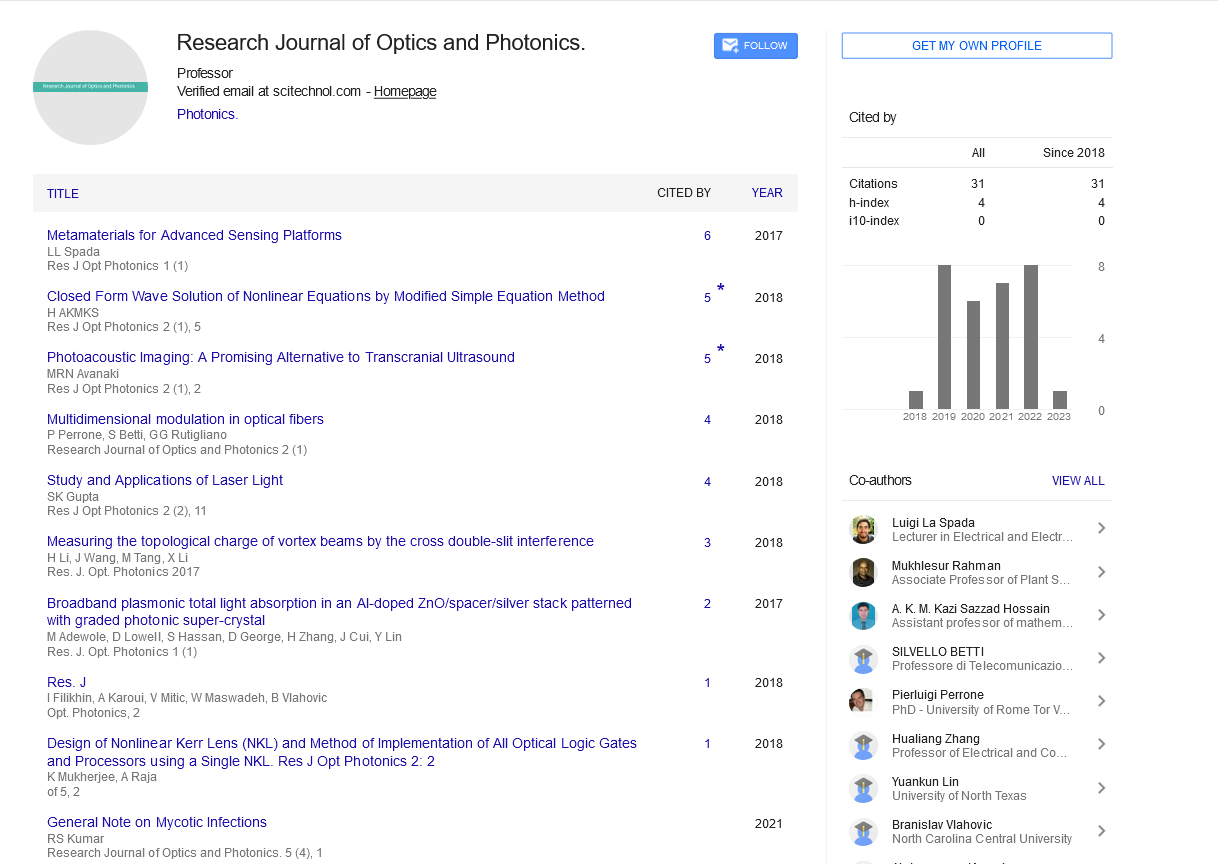Perspective, J Opt Photonics Vol: 7 Issue: 4
Quantum Optics Importance in Information Processing from Photons to Qubits
Hang Chen*
1Department of Electronic Engineering, Tsinghua University, Beijing 100084, China
*Corresponding Author: Hang Chen,
Department of Electronic Engineering,
Tsinghua University, Beijing 100084, China
E-mail: Hang@1456378.cn
Received date: 22 November, 2023, Manuscript No. RJOP-24-128324;
Editor assigned date: 24 November, 2023, PreQC No. RJOP-24-128324 (PQ);
Reviewed date: 08 December, 2023, QC No. RJOP-24-128324;
Revised date: 15 December, 2023, Manuscript No RJOP-24-128324 (R);
Published date: 22 December, 2023, DOI: 10.4172/RJOP.23.7.1000052.
Citation: Chen H (2023) Quantum Optics Importance in Information Processing from Photons to Qubits. Res J Opt Photonics 7:4.
Description
In the quest for faster, more secure, and more efficient information processing, traditional methods are encountering fundamental limits. Enter quantum optics, a field at the forefront of a revolutionary paradigm shift in computing and communication. By exploiting the principles of quantum mechanics, particularly the behavior of particles like photons and qubits, quantum optics promises to transform information processing. This essay explores the pivotal role of quantum optics in information processing, tracing the journey from photons to qubits and the extreme implications for the future of technology. Quantum optics, at its core, explores the interaction between light and matter at the quantum level. Light, in the form of photons, serves as a carrier of quantum information, while matter, such as atoms, ions, and solid-state systems, acts as quantum processors. By harnessing the unique properties of quantum systems, such as superposition and entanglement, quantum optics enables the manipulation and transmission of information in ways that were once thought impossible.
One of the key applications of quantum optics in information processing is quantum communication. Traditional communication methods, relying on classical bits represented by either 0s or 1s, are susceptible to interception and eavesdropping. Quantum communication, on the other hand, offers unprecedented security through the use of Quantum Key Distribution (QKD) protocols, which use the principles of quantum mechanics to generate unbreakable cryptographic keys. By encoding information in the quantum states of photons, such as their polarization or phase, quantum communication systems ensure the privacy and integrity of transmitted data, even in the presence of a determined adversary. Furthermore, quantum optics plays a central role in the development of quantum computing, a revolutionary approach to information processing with the potential to solve complex problems far beyond the reach of classical computers. At the heart of quantum computing lies the qubit, the quantum analogue of a classical bit. Unlike classical bits, which can only exist in a state of 0 or 1, qubits can exist in a superposition of both states simultaneously, enabling parallel computation and exponential speedup for certain tasks.
In quantum computing, photons serve as ideal qubits due to their low decoherence and ease of manipulation. Quantum optical systems, such as optical cavities, waveguides, and photonic circuits, provide the necessary infrastructure for encoding, manipulating, and measuring qubits with high precision and efficiency. Photonic qubits can be entangled over long distances through processes such as Spontaneous Parametric Down-Conversion (SPDC) or photon-pair sources, enabling the realization of distributed quantum networks for quantum computing and communication. Moreover, quantum optics enables the implementation of quantum algorithms, such as Shor's algorithm for factoring large numbers and Grover's algorithm for database search, which offer exponential speedup over their classical counterparts. These algorithms harness the power of quantum parallelism and interference to solve computational problems with unprecedented efficiency, promising transformative applications in cryptography, optimization, machine learning, and drug discovery.
Conclusion
In addition to quantum communication and computing, quantum optics finds applications in quantum metrology, sensing, and imaging. Quantum-enhanced sensors, such as atomic clocks and magnetometers, utilize quantum coherence and entanglement to achieve unprecedented precision and sensitivity, enabling advancements in navigation, geodesy, and fundamental physics. Quantum imaging techniques, such as ghost imaging and quantumenhanced microscopy, leverage quantum correlations to achieve superresolution imaging and imaging through scattering media, with potential applications in biomedical imaging, remote sensing, and security screening. Looking ahead, the future of quantum optics in information processing holds immense promise and potential. As researchers continue to push the boundaries of what is possible, quantum optical technologies will play an increasingly prominent role in shaping the technological landscape of the 21st century. From secure communication networks to powerful quantum computers, from ultrasensitive sensors to advanced imaging systems, quantum optics will enable a new era of innovation and discovery, unlocking new frontiers in science, engineering, and beyond.
 Spanish
Spanish  Chinese
Chinese  Russian
Russian  German
German  French
French  Japanese
Japanese  Portuguese
Portuguese  Hindi
Hindi 